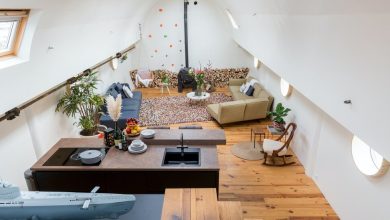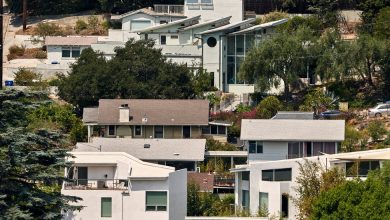The A.D.U. Experiment

The two buildings going up on a corner on Linden Lane in Princeton, N.J., are part of an experiment.
They share a 0.19-acre, single-family lot, but are entirely separate, except for a shared carport between them.
The larger, a 2,300-square-foot, four-bedroom house, is listed for $1.295 million. The other one, a 1,400-square-foot, two-bedroom home, is what’s known as an accessory dwelling unit, or A.D.U. It is listed, on its own, for $849,000, a rarity in an affluent town where the median sale price hovers around $1 million.
“You tell someone that $800,000 is affordable, and they will look at you like you’re crazy,” said the builder, Daniel Barsky, an owner of R.B. Homes. “But in Princeton, it’s affordable, particularly for new construction.”
Mr. Barsky and his father, Roman Barsky, are the first builders to take full advantage of Princeton’s relatively new A.D.U. ordinance, one of the most progressive in the region, to create what amounts to affordable housing there. But while this community of roughly 30,000 residents is ahead of the curve, it is not alone: The concept is beginning to catch on elsewhere in the New York metro area. Earlier this year, Connecticut passed a law allowing A.D.U.s in all single-family zones, and a coalition in New York is working to build support for similar legislation.
A.D.U.s — defined as accessories to an existing home, either as an attached apartment or as a smaller, detached dwelling — are typically rental units. But Princeton has gone a step further in allowing them to be sold separately from the primary residence, as condominiums. The town’s ordinance was shaped in part by a lawsuit filed by Marina Rubina, a political activist and the architect who designed the project on Linden Lane.
“We really are the guinea pig” in the New York metro area, said Mia Sacks, a Princeton councilwoman and an advocate of the new ordinance.
Proponents of A.D.U.s say they are a smart way to supply the so-called “missing middle” price range of housing. They can also generate rental income for seniors struggling to afford to stay in their homes, and make communities more economically and racially inclusive. That makes them highly suitable for Princeton, where “our zoning has made us a gated community,” Ms. Sacks said.
But how well they will fit in remains to be seen. The Linden Lane project is raising a lot of eyebrows. Derek Bridger, the zoning officer, said he has fielded a number of calls from residents wanting to know how it is possible to build two homes on a single lot.
“People were kind of startled by it,” Mr. Bridger said, but “the current Council is very proactive in trying to establish new housing opportunities. There’s no land left, so it’s challenging.”
The Rise of the A.D.U.
Earlier forms of the A.D.U., known as granny flats or in-law apartments, were relatively common before World War II. But postwar suburban zoning created barriers to such housing, in favor of single-family homes. Now A.D.U.s are again rising in popularity in high-growth, high-cost areas like Seattle, Los Angeles, Austin, Texas, and Portland, Ore., as policymakers loosen zoning constraints to encourage their development.
A July 2020 report from Freddie Mac found that the national share of active, for-sale real estate listings with A.D.U.s had increased to 6.8 percent in 2019 from 1.6 percent in 2000. (The data did not distinguish between permitted A.D.U.s and illegal units added without approvals.) Half of the 1.4 million A.D.U.s identified in the study were in California, Florida, Texas and Georgia, all fast-growing states.
In the tristate area, the Regional Plan Association has been actively supporting A.D.U.s as “a low-impact” strategy for expanding housing options for seniors and young adults. While resistance can run high at the local level, where homeowners are often wary of increased density, Melissa Kaplan-Macey, the association’s vice president for state programs and Connecticut director, said that there has been a “temperature shift” around the issue since the pandemic: “The past year and a half has shined a bright light on the need for safe housing and the range of people that are needed to keep a community going.”
From a social equity standpoint, A.D.U.s can provide a housing option in neighborhoods that might not otherwise be accessible to lower-income households or people who want to age in place, said Phil Abramson, the founder and chief executive of Topology, a professional planning firm in Newark.
But there can be considerable tension around the idea of making a second dwelling a permitted use in a single-family neighborhood, he said: “Then the question is, are we taking away the single-family zoning?”
What’s in the Works
In Maplewood, N.J., officials found that residents were receptive to the idea of A.D.U.s when an ordinance was proposed last year. The first version allowed only seniors to create or live in an A.D.U., said Dean Dafis, the deputy mayor. But after social justice advocates objected, saying the opportunity should be open to all, the ordinance was amended.
“We were surprised — we thought this was going to be controversial,” Mr. Dafis said. “And then we were sort of blindsided by the interest.”
Connecticut’s new law permits A.D.U.s in all single-family zones as of right — meaning no public hearing or special permit is required to build them. While many Connecticut towns already allowed accessory apartments, Desegregate Connecticut, the housing coalition that proposed the legislation, found that the restrictions varied widely and were often onerous. The new law removes some of the barriers, but also includes an opt-out provision: Municipalities may choose not to comply if their zoning commissions and municipal legislative bodies vote accordingly before January 2023.
The legislation proposed in New York would legalize A.D.U.s statewide. It calls for the creation of a lending program to help low- and moderate-income homeowners secure financing to add an A.D.U. or bring an existing unit up to code. The legislation is still being tweaked, to address concerns around the size of units, parking and other issues, said State Senator Peter Harckham, a lead sponsor.
In Princeton, Council members are already talking about revisiting the terms of their ordinance. Ms. Sacks said that the A.D.U. on Linden Lane designed by Ms. Rubina, while legal under the ordinance, is “larger and more expensive than is ideal for what we would like to accomplish.”
But R.B. Homes took a risk in being the first to try out a “mama bear” and “baby bear” scheme, Ms. Rubina argued, noting that builders could have chosen instead to put up another McMansion. If they had built a single house of more than 5,000 square feet, she pointed out, they could have easily sold it for upward of $1.5 million.
How It Began in Princeton
Princeton’s ordinance was adopted in 2020, after Ms. Rubina, a founder of the Princeton Progressive Action Group, sued the municipality, which allowed rental flats in single-family homes, but required the homes to be owner-occupied and did not allow the flats to be owned separately.
Ms. Rubina had bought an older home with a ground-floor apartment on Leigh Avenue, in the historic Witherspoon-Jackson neighborhood, with the intention of renovating it and renting or selling both units. Under the existing regulations, she could do neither.
“I just thought that was incredibly strange,” Ms. Rubina said.
And possibly illegal. Her lawsuit largely relied on a 2019 ruling by the Appellate Division of the state Superior Court in which the owner of a house with an attached apartment in Point Pleasant Beach had challenged a similar owner-occupancy requirement. The court declared the requirement “invalid and unenforceable,” as zoning is for the purpose of determining the use of property, not the identities of the occupants.
Ms. Rubina’s lawsuit had the effect of advancing a conversation about A.D.U.s that was already taking place on the Council. “Princeton was ready — we pushed on a somewhat open door,” said Christopher Tarr, Ms. Rubina’s lawyer.
In June 2020, the Council replaced the old ordinance with one allowing A.D.U.s in residential zones, later altering the terms to allow for the sale of each unit independently, effectively resolving Ms. Rubina’s legal claims. Ms. Rubina has since completed the project at the heart of the lawsuit. The three-bedroom dwelling upstairs sold for $760,000; the ground-floor, one-bedroom unit sold for $427,000.
Ms. Sacks called the project “a great example” of what the Council hopes to accomplish with the ordinance: “You cannot buy anything for $450,000 in Princeton. If you were to redo that house as a single-family home, you would sell it for over $1 million. This is making it possible for two families to move in, in a lower price range.”
Seniors also stand to gain, she said, noting that her own mother, Donna Wilkinson Nitchun, has benefited from the rental unit attached to her home in Princeton for more than 20 years.
“She can pay the taxes, put food on the table, and meet people from all over,” Ms. Sacks said. And the tenants, who are often affiliated with Princeton University, “keep an eye out for her, take out the garbage, help with yard stuff. It’s a tremendous source of connection for her.”
For many of the same reasons, the AARP is a big supporter of A.D.U.s.
“We know from our surveys that well over three quarters of people over 50 want to age in place at home in their community, but less than half think they will be able to,” said Danielle Arigoni, the director of the AARP’s Livable Communities program. “They don’t see viable housing solutions when they look around them. A.D.U.s are a really elegant solution to diversifying the choices that people have in housing.”
Of course, the cost of building A.D.U.s is another matter. The Federal Housing Finance Agency is currently weighing updates to its policies to make it easier to finance the construction of A.D.U.s. At a recent listening session held by the agency, Mike Hernandez, vice president of engagement and impact for Fannie Mae, the mortgage financing giant, said it was working with lenders to lower the cost of mortgages for homes with A.D.U.s; was helping homeowners pay for the construction of A.D.U.s using HomeStyle Renovation loans; and was testing the use of cash-out refinancing to pay off second mortgages and construction loans used to finance the building of A.D.U.s.
As the experiment unfolds in Princeton, one of the unknowns is how having an A.D.U. condominium will affect the value of the primary residence, said Judson R. Henderson, the broker of record at Callaway Henderson Sotheby’s International Realty, in Princeton. Will the additional value from the A.D.U. make up for any devaluing of the main residence for homeowners who, say, convert a garage and sell it off?
Given the ceaseless demand for housing in Princeton, he added, “in four or five years, I don’t think it’s going to matter. There will be plenty of people that have done this, and it will just be part of the marketplace.”
For weekly email updates on residential real estate news, sign up here. Follow us on Twitter: @nytrealestate.




